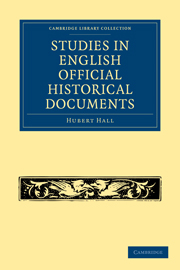Book contents
- Frontmatter
- PREFACE
- Contents
- ERRATA
- PART I THE SOURCES OF OFFICIAL HISTORICAL DOCUMENTS
- PART II THE DIPLOMATIC OF OFFICIAL HISTORICAL DOCUMENTS
- PART III THE PALAEOGRAPHY OF OFFICIAL DOCUMENTS
- INTRODUCTION TO THE PALAEOGRAPHY OF OFFICIAL DOCUMENTS
- PALAEOGRAPHY
- APPENDIX I Table showing the Evolution of English Writing
- APPENDIX II Classification of the Bibliography of Palaeography
- TABLE OF MATTERS
INTRODUCTION TO THE PALAEOGRAPHY OF OFFICIAL DOCUMENTS
Published online by Cambridge University Press: 07 September 2010
- Frontmatter
- PREFACE
- Contents
- ERRATA
- PART I THE SOURCES OF OFFICIAL HISTORICAL DOCUMENTS
- PART II THE DIPLOMATIC OF OFFICIAL HISTORICAL DOCUMENTS
- PART III THE PALAEOGRAPHY OF OFFICIAL DOCUMENTS
- INTRODUCTION TO THE PALAEOGRAPHY OF OFFICIAL DOCUMENTS
- PALAEOGRAPHY
- APPENDIX I Table showing the Evolution of English Writing
- APPENDIX II Classification of the Bibliography of Palaeography
- TABLE OF MATTERS
Summary
The definition of Palaeography as the study of mediaeval writing at large cannot be wholly disregarded even for the purpose of a brief essay on the official writing of this country, which can scarcely be distinguished as such before the close of the 11th century. By common consent, an elementary knowledge of the evolution of writing since the beginning of the Christian era is requisite for the study of the earlier specimens of the national writings of Western Europe. It is true that the exact division in point of date between the classical and the national writings would seem to be of less moment in our own case, since we are told that the Anglo-Irish script is not derived, like the continental type, from a Roman Cursive stock. But even if the native “graffites” or other literary remains of the Roman civilization in Britain may have had no influence on the Anglo-Saxon or the Anglo-Irish calligraphy, this early writing is still worthy of our attention. For if we can derive much profit from the comparative study of the continental diplomata and capitularies from the 8th to the 11th centuries, we should not grudge the pains of acquiring some knowledge of the system on which these documents were constructed. Again, we shall find that, from the 9th century onwards, the successive styles of Franco-Roman and Gothic writing which prevailed throughout Western Europe may be regarded as a common national script.
- Type
- Chapter
- Information
- Studies in English Official Historical Documents , pp. 355 - 359Publisher: Cambridge University PressPrint publication year: 2010First published in: 1908
- 1
- Cited by



